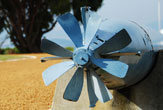Why Does South Korea Think That North Korea Sank Their Ship?

An explosion last month that ripped a hole in the hull of the South Korean warship the Cheonan immediately triggered an investigation into the cause of the blast. After using a combination of forensic tools, military analysis and political calculation in a month-long inquiry, South Korean government officials announced that a North Korean torpedo most likely blew up the Cheonan.
The results of these inquests can have dramatic political ramifications, sometimes even starting wars, so forensic investigators need to assemble a chain of evidence as clearly and objectively as detectives putting together an indictment, John Pike, Director of GlobalSecurity.org and a military analyst, told Life's Little Mysteries.
A mistaken belief that a mine, not an internal malfunction, sank the USS Maine precipitated the Spanish-American War in 1898, and similarly high tensions between North and South Korea demanded that this incident be handled carefully.
First, forensic investigators would have looked at the ship's hull to determine whether the blast came from outside or inside the ship, Pike said. If the remaining metal shards around the hole bend inward, as they did on the South Korean ship, then investigators can rule out internal malfunctions as the cause and conclude that external forces were at work. Next, the South Korean investigators would have looked at the size of the hole, Pike said. A larger, shallower, hole would indicate a blast from a sea mine, while a smaller, deeper, hole would indicate a torpedo.
That difference is important. A mine blast could be accidental, but a torpedo strike could only result from deliberate aggression.
Once investigators concluded the blast was an attack, they would have needed to figure out the identity of the attacker. In this case, geography likely did most of the work.
"I mean, who else was going to do it? The only country that has spend a half century threatening South Korea is North Korea," Pike said.
Get the world’s most fascinating discoveries delivered straight to your inbox.
While the case of the Cheonan seems more open and shut, in less obvious instances, investigators can fall back on chemical, metallurgical and physical analysis. Each country uses a unique mixture of casings, explosives and devices, and intelligence services keep records of these. When an attack occurs, investigators can compare the explosive residues, metallic shrapnel bits and explosion characteristics to their files, and match the profile of a particular weapon to its country of origin, Pike said.
- Top 10 Greatest Explosions Ever
- Who Has Nuclear Weapons?
- Environmentally Friendly Bombs Planned


